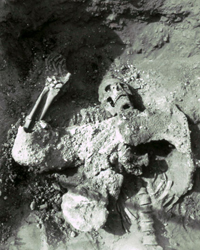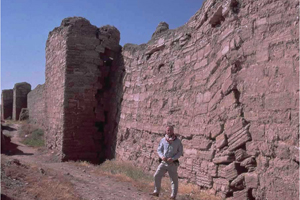Researchers from the University of Leicester in the UK have apparently identified evidence of Roman-era chemical warfare in an archaeological dig in Syria

At a meeting of the American Institute of Archaeology, University of Leicester researchers claimed that 20 Roman soldiers found in a besieged mine in the city of Dura-Europos in Syria, died not as a result of sword or spear penetration but as a result of suffocation.
Dora-Europos on the Euphrates River was conquered by the Romans and a large garrison was stationed in the city. Around 256 AD the city was under a brutal siege by the Sassanid Empire, a new Persian Empire that had begun to weave skin and sinew. There is no text describing the events so everything we know has been known entirely from the archaeological remains in the area. Recently, excavations that began during the 20s and 30s were renewed, and amazing discoveries began to emerge.
The Sasanian warriors who besieged the city used almost every possible technique at their disposal in order to break into the besieged city - this included mining operations in the mines under the walls designed to collapse the city walls, but the Roman defenders responded with 'countermining' to withdraw the attackers.

In the 30s, the bodies of twenty Roman soldiers in their uniforms were found in one of the narrow tunnels in the besieged mine where both sides fought. During the new excavations, archaeologist Simon James treated the area as a crime scene and tried to understand how the Roman soldiers died if there were no stabbing or struggle marks on their bodies.
Dr. James said that, “When mining met counter-mining, the Romans lost the fight. A careful analysis of the arrangement of the bodies shows that they were piled up at the end of the tunnel by the Persians. The use of victims created a wall of corpses and a natural shield that stopped the Roman attack in the narrow area, at the same time the Persians set fire to the mine and undermined its foundations to allow the Persians to collapse the city walls. This explains why the bodies were found where they were. The question is how did they die? For the Persians, killing twenty people in a space less than two meters wide and less than two meters high and 11 meters long requires unusual fighting skills - or alternatively, cunning trickery."
Findings from the Roman tunnel reveal that the Persians used bitumen and crystal sulfur for ignition, these provided James with the vital clue to his findings. When ignited, these materials create a compressed cloud of suffocating gases.
"The Persians heard the Romans digging and prepared a nasty surprise for them," said James. In his opinion the Persians prepared the chemicals ahead of time and when the Romans broke in, the poisonous gases were pumped into the Roman tunnel. In a few seconds the Roman soldiers lost consciousness and in a few minutes they lost their lives.

In fact, the use of smoke generators of this type during the siege of mines is mentioned in classical texts, and the current archaeological excavation at Dora-Europos indicates that the Sasanian Persians knew how to use this tactic.
Ironically, the Persian mining failed to bring down the walls, but it is clear that somehow the Sasanians managed to penetrate the besieged city. Recently James excavated a 'belt of shooting machines', a series of ready-to-use catapult bolts aimed at the Roman walls and the Roman camp within the city. The defenders and inhabitants were slaughtered or exiled to Persia, the city was abandoned forever, and the city's gruesome secrets remained until modern times when modern archaeologists began to uncover them in excavations.

7 תגובות
The Sasanians then the Iranians today, the day of judgment is coming
Or put in some remote museum
I wonder what you do with all the bones you find? Do they bury them in a mass grave with a tombstone on it indicating the event and the year the people died?
It's just you…
Is it just me or does this remind me of the awards in the movie 300?
You meant to say: there were criminals!
Or I'm wrong, and basically every Roman who left the territory of Italy - Rome was actually a good soul.
I would very much like to see photos from the aforementioned excavations. If anyone can tell me, I would be very happy.
Thanks
The Romans throughout history were bad, violent people...